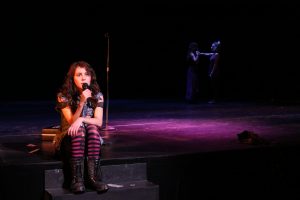 Spacing, Whitman’s Fall Dance Concert, ended with some audience members returning to see the performances a second time. I had the opportunity to speak with Whitman Junior, Sabina Rogers, to discuss her participation in Margins of Prophecy choreographed by Whitman Assistant Professor of Dance Peter de Grasse, in collaboration with other performers.
Spacing, Whitman’s Fall Dance Concert, ended with some audience members returning to see the performances a second time. I had the opportunity to speak with Whitman Junior, Sabina Rogers, to discuss her participation in Margins of Prophecy choreographed by Whitman Assistant Professor of Dance Peter de Grasse, in collaboration with other performers.
Nhi Cao: Can you tell me about the piece that you are performing?
Sabina Rogers: Yes! For me, our piece is a mixture of things. One moment you are met with total absurdity as different gestures and voices gather your peripheral and then, as soon as you work yourself up to a mild sweat, the atmosphere shifts from chaos to stillness. And we sit in this stillness for a ridiculous amount of time. I think maybe we wanted to freak the audience (and ourselves) out a little. This piece is a clay to brick or I guess maybe more of a sand to glass kind of process. It came about through conversations and improvisations and not-knowing and then kind-of-maybe-knowing what we wanted to do with our twenty minutes on stage. It’s cool because it incorporates dimensions of dance, theater, performance art, singing, and various other shenanigans largely inspired by Peter’s time in Germany where he studied the interdisciplinary dance form “Tanztheater,” which I believe just means “dance theater.” Overall, it’s lyrical, poetic, nonsensical, and at times intentionally overdone.
NC: “Intentionally overdone”, please tell me more about that.
SB: Hmm perhaps overdone isn’t the right word. I’d say that at various moments we impel exaggerations. From my perspective, the piece doesn’t rely on subtle symbolism. At one point we literally show the audience a sign that says “sex.” So we don’t expect a lot of questions like, “Do you think that was a reference to SEX?” It probably definitely was. However, this absolutely does not imply a lack of ambiguity. This piece is open for alllllll types of interpretations and it really relies on individual interpretations, because heck I don’t even know what it means half the time. If the piece desired a narrative it would likely fall into the category of montage. As a group, we have asked a lot of questions about the relationship between audiences and performers. Like, how are performers fetishized and commodified? To what extent does the audience own the performers and how might the performers manipulate this power dynamic?
NC: I want to be in the front row.
SR: You should be in the front row! You’ll maybe get stuff thrown on you! But yeah it’s going to be a lot… Some people are probably going to hate it and others will love it. The reactions will be all over the place, and I think we’re ok with that, because the piece is what it is at this point. We incorporate back to back irony and sincerity throughout the piece and sometimes that tension of “Is this serious or not?” can be read as insensitive. And that is completely valid.
NC: How long have you been rehearsing for this performance?
SR: For about five weeks.
NC: And how far do you think the team have come from that starting point?
SR: That’s a good question. I would say however far we’ve come as a team is less evident in our piece than it is in our relationship with each other. For me, this piece is much less about the performances than it has been about the process of building genuine and trusting relationships with Emily, Amara, and Beatrice (who also happen to be total rockstars on and off the stage).
